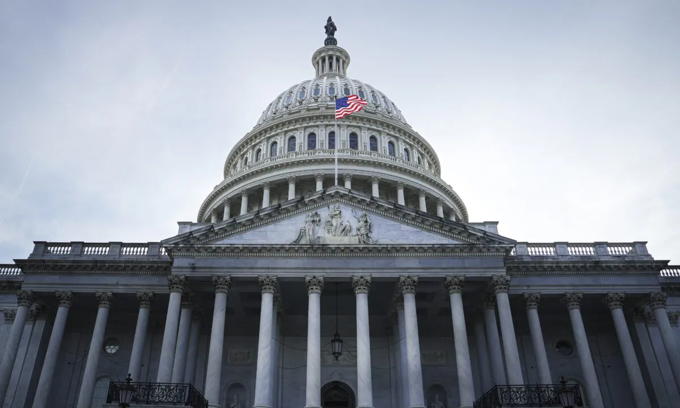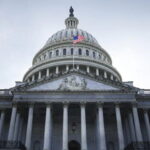Credit rating agency Moody’s has cut its outlook for the U.S. government from “stable” to “negative” due in large part to out-of-control spending.
Moody’s said in a Nov. 10 announcement that it has lowered its ratings outlook on the U.S. government to “negative,” citing a lack of restraint on spending while predicting that deficits will remain “very large” for the foreseeable future.
“In the context of higher interest rates, without effective fiscal policy measures to reduce government spending or increase revenues, Moody’s expects that the US’ fiscal deficits will remain very large, significantly weakening debt affordability,” the agency said.
Too much government spending was also the reason why rating agency Fitch went a step further than Moody’s and downgraded America’s credit rating from AAA to AA+ over the summer.
While Moody’s decided to cut the U.S. outlook to “negative,” it opted to keep the country’s overall rating at AAA.
Predictably, the U.S. Treasury Department objected to the outlook downgrade, much as it did when Fitch cut the rating.
“While the statement by Moody’s maintains the United States’ AAA rating, we disagree with the shift to a negative outlook,” Deputy Treasury Secretary Wally Adeyemo said in a statement. “The American economy remains strong, and Treasury securities are the world’s preeminent safe and liquid asset.”
The outlook cut comes hot on the heels of reports that interest payments on the massive pile of U.S. government debt have exceeded $1 trillion per year for the first time in history, on roughly $33.6 trillion of total public debt outstanding. Little improvement is in the cards on either count.
Debt In Focus
U.S. government outlays for interest are expected to rise from roughly 2.5 percent of gross domestic product (GDP) in 2023 to 6.7 percent in 2053, according to the latest long-term budget outlook from the Congressional Budget Office (CBO).
The level of America’s public debt is also expected to rise, reaching around 181 percent of GDP by 2053, up from the current 98 percent of GDP, according to the CBO.
Meanwhile, U.S. Treasury data shows that, as of Nov.9, the total outstanding public debt stood at $33.58 trillion. This includes $7.04 trillion in intragovernmental holdings and another $26.66 trillion in debt held by the public.
Besides out-of-control government spending, Moody’s also cited political brinkmanship in Washington as a factor behind its decision to slash the outlook for U.S. government debt.
“Continued political polarization within US Congress raises the risk that successive governments will not be able to reach consensus on a fiscal plan to slow the decline in debt affordability,” Moody’s said.
Still, despite the disorder in America’s fiscal house, Moody’s opted to retain the nation’s overall credit rating at AAA, in part due to relatively strong economic performance, which could offset some of the impacts of high interest rates on debt servicing costs.
“Further positive growth surprises over the medium term could at least slow the deterioration in debt affordability,” Moody’s said while adding that it expects the United States to “retain its exceptional economic strength.”
The latest government data shows that the U.S. economy grew at an annualized pace of 4.9 percent in the third quarter, a solid pace that Federal Reserve board member Christopher Waller called a “blowout” that warrants watching as the Fed considers its next moves on interest rates.
In response to soaring inflation, the Fed has embarked on an interest rate hiking cycle at a feverish pace, taking rates from near zero in March 2022 to within their current range of between 5.25-5.5 percent.
While the impact of the rate hikes has yet to bring inflation down to the Fed’s 2 percent target, the central bank’s moves have driven up borrowing costs, starving the economy of credit and prompting fears of recession and stagflation—a toxic combination of sluggish growth and high inflation.
Billionaire investor Ken Griffin, the founder of hedge fund Citadel, recently warned that higher baseline inflation could persist for decades, with negative implications for the cost of interest payments on the massive—and growing—pile of government debt.
Interest Rate Chatter
Inflation has fallen from its recent peak of 9.1 percent in June 2022 to 3.7 percent in September 2023. Certainly an improvement, but nearly double the 2 percent pace that the Fed sees as a sweet spot between price stability and economic growth.
Even though the inflation numbers have improved, some experts point out that prices continue to rise—just at a slightly slower pace.
“Slower inflation is an oxymoron to consumers that take no solace in the fact that prices aren’t rising as fast, because they are still rising,” Greg McBride, chief financial analyst at Bankrate, told The Epoch Times in an emailed statement.
“The cumulative effect of inflation has strained household budgets and undermined buying power, with the Consumer Price Index up more than 18 percent in the past three years,” he added.
Next week, the U.S. government will release the latest inflation figures, with analysts saying that an upside surprise would undermine the view that the Fed is done raising rates and potentially send shock waves across stock and bond markets.
Besides watching for the upcoming inflation numbers, investors will also be keeping a close eye on potential future ratings moves by Moody’s and others, as a change in a rating agency’s can—but doesn’t always—precede a credit rating downgrade.



















The actual cost of buying votes, due to lack of true leadership.
The dirty politicians in Washington (RINOS and the communist Democrats) spending our Country into the abyss of bankruptcy. This shows one, how much the filth in Washington, cares about the American people.
This is EXACTLY why we need a businessman (Donald Trump) in the White House instead of corrupt, self-righteous, self-serving professional politicians.
This Treasonous, dishonest, destructive, woke, immoral, Socialist Democrat Party’s objective is to deliberately lie, cheat and steal. To disregard the U.S. Constitution and our laws, in order to take total control of the American people by restricting U.S. citizens their constitutional rights and freedoms, including freedom of speech. Stopping oil production, increase Spending, Taxes and the inflation cost of everything and bring American commerce and economy to its knees and to promote Socialism, enforced by their political DOJ, their FBI Gestapo and IRS.
Then access power and retain it by any means available –
No matter the costs to the people, the government or the nation.
This treasonous, destructive, immoral, lying, woke, socialist, tax and spend Democrat Party, their Democrat RINOs and their corrupt, demented, obedient sock-puppet president Joe Biden has become our country’s most destructive and deadliest ENEMY!
Hi Scruffy. During Trump’s four years as president, the national increased $6 trillion. That was the highest four year increase ever, a record. It’s not a demoncrapic thing. It’s a politician and SWAMP SCUM thing. Just look at McCarthy during his eight month stint as Speaker of the House. Nothing to save us even a dime. Quite the opposite.
THe only reasons he had to increase it, WAS CAUSE OF COVID and the war…
Biden increased by over $4.8 trillion. To be exact, between January 20, 2021 and July 20, 2023, the total national debt under Biden rose from $27,751,896,236,415 to $32,592,226,328,901 and we have 14 months still for the Democrats to spend even more!
Hi backpacker. The dirty politicians in the SWAMP (from both parties) has one concern and care about only one thing. THEMSELVES.
True dat!!